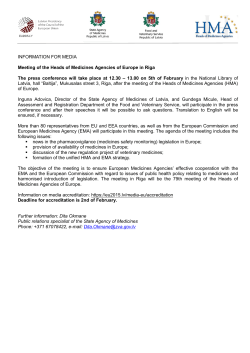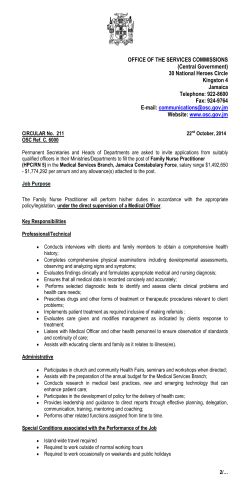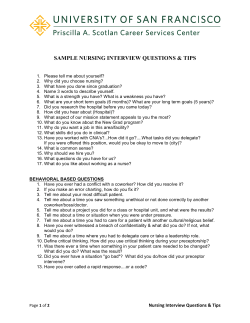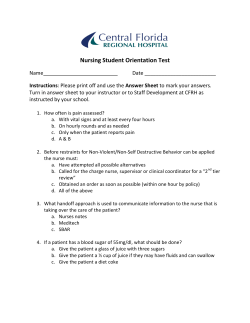
Nurse Prescribing - the U21 Health Sciences group`s website!
Nurse Prescribing: Issues for Consideration Associate Professor Elizabeth Manias The University of Melbourne Aim of Session Changing context of health care Nurse prescribers in Australia Regulation of role Scope of practice of nurse prescribers Dissenting view of medical profession, other prescribers Review of Victorian legislation Endorsement process in Victoria Australia National Medicines Policy, Quality Use of Medicines Possible future directions 1 Changing Context of Health Care Increased consumer knowledge →↑ consumer demands. Economic rationalism (Cumberledge Report, 1986). Time conscious society (Crown Report, 1989). Technological advances. ↑ incidence of chronic disease. ↑ ageing population. Nurse Prescribers in Australia Nurse practitioner: individual who has been given authority to prescribe. Development of nurse prescriber role (nurse practitioner): more recent process. New category of accreditation in Australia: nurse practitioner. Process complicated by lack of uniformity nationally and internationally. 2 Regulation of Nurse Prescribers in Australia Regulation of nursing profession is a responsibility of state and territory governments. Progress varies between jurisdictions. E.g. Some states have already appointed nurse prescribers, while others are persisting with pilot and demonstration projects. Definitions Role: seeks to co-ordinate, integrate, educate and provide clinical expertise to patients. Victorian Nurse Practitioner Taskforce (2000): ‘a registered nurse, educated for advanced practice who is an essential member of an interdependent health care team and whose role is determined by the context in which s/he practices’. 3 Definitions International Council of Nurses: ‘a registered nurse who has acquired the expert knowledge base, complex decision-making skills and clinical competencies for expanded practice, the characteristics of which are shaped by the context and/or country in which s/he is credentialed to practice. A master’s degree is recommended for entry level. Core Components of Role Clinical practice Education Counselling Research Leadership Thus role is beyond the act of prescribing. Role involves multifaceted approach, promoting preventative and integrative care. 4 Scope of Practice Distinguishing features: Medication management that includes prescribing and formulating according to defined clinical practice guidelines. Initiate diagnostic investigations Provide referrals to medical specialists. Have admitting and discharging privileges. Approve absence of work certificates. Dissenting View of Medical Profession Australian Medical Association: 1999 US health system: prohibitively high costs for poor and indigent. UK health system: gross undersupply of medical practitioners. Australia: universal health system with bulkbilling. Rural areas: focus on a recruitment drive. Close collaborative networks with neighbouring towns. 5 Dissenting View of Medical Profession Australian Medical Association: 1999 Danger of prescribing: - 6% of all admissions to hospital are related to adverse events due to medication therapy. - Adverse events associated with poor coordination of care, consultation of patients with other medical practitioners and poor communication between health professionals. Prescribing Rights of Health Professionals Optometrists Prescribing rights in Victoria since 2000. Podiatrists Have prescribing rights in some states (WA and SA) Podiatrists in Victoria: administer anaesthetics, antifungal agents. Pharmacists Completion of home medication reviews. Nurses Already managing wide variety of medications in patients with severe acute, lifelife-threatening conditions. 6 Legislation Nurses Act 1993 (Vic) amended with Nurses Amendment Act 2000 – to include nurse practitioners. Drugs, Poisons and Controlled Substances Act 1981 amended. Permit nurse practitioner to obtain or have in their possession and to use, sell, or supply Schedule 2, 3, 4 or 8 poisons. Endorsement as a Nurse Practitioner/Prescriber Criterion 1: Evidence of current registration. Criterion 2: Evidence of educational background and clinical experience relating to category of nurse practitioner being sought. Masters degree: completion of Therapeutic Medication Management module. Criterion 3: Requirement to extend scope of practice. Supported by clinical practice guidelines developed by nurse. 7 Endorsement as a Nurse Practitioner/Prescriber Criterion 4: Evidence of involvement in research and/or continuous quality improvement activities. Criterion 5: Evidence of leadership in practice area in which endorsement is sought. Criterion 6: Evidence of professional indemnity. National Medicines Policy Stimulated by the World Health Organisation → countries encouraged to implement national medicinal policies. Purpose: availability of essential affordable drugs of acceptable quality, safety and efficacy. Comprehensive policy in place: 1999 8 National Medicines Policy Timely access to the medicines that Australians need, at a cost individuals and the community can afford. Medicines meeting appropriate standards of quality, safety and efficacy. Quality use of medicines. Maintaining a responsible and viable medicines industry. Quality Use of Medicines: Principles Selecting management options wisely: drug versus non-drug treatment. Choosing suitable medicines if a medicine is considered necessary: appropriate selection of a medicine. Using medicines safely and effectively. 9 Quality Use of Medicines: Why is a Focus on QUM Necessary? Growing recognition that medications were a part of life for most Australians. 2001 National Health Survey: 76% women/65% men used prescribed or OTC medicines. 30% used vitamins or minerals 50% used analgesics 5% used sleeping medication 2% used antipsychotic medications 2 to 3% of all hospital admissions relate to medication problems: overover-use, underunder-use and inappropriate use of medications (Australian Council for Safety and Quality in Health Care, 2002) Quality Use of Medicines: Known Problems Currently at least 80,000 hospital admissions annually related to medication misuse. Inappropriate selection: nonsteroidal antiinflammatory drugs, antibiotics, respiratory drugs. Excessive use: antibiotics, benzodiazepines, antidepressants. Under-use: medications to treat the following: hypertension (silent disease), asthma, diabetes, immunisable conditions, heart failure, post myocardial infarction, gastrointestinal ulcer. ( ACSQHC, 2002) 10 Quality Use of Medicines: Bringing about a Change Education should occur within a QUM framework. Heterogeneity and diversity across Australian community needs to be recognised - health beliefs, health literacy, socioeconomic status, geographic isolation, access to information technology → consumer is central. Partnerships between stakeholders. Independent information. Quality Use of Medicines: Consumer Medicines Information (CMI) - CMI for all prescription medicines by 2002 Accurate and up to date. Generally easy for consumers to use. Well written. Clear headings. Simple instructions. 11 Quality Use of Medicines: Independent Information Therapeutic Advice and Information Service (TAIS) National Prescribing Service News Medicines Line Australian Prescriber Rational Assessment of Drugs and Research (RADAR) Australian Medicines Handbook Therapeutic Guidelines Quality Use of Asthma Medicines Workshop How to ensure information provided is consumer driven, and takes into account the consumers’ beliefs, attitudes, sense of agency. Nurse prescribing cannot be decontextualised from the environment. Identify specific information and knowledge to be disseminated. Use multiple strategies which engage individuals in different ways. Analyse needs and performance in the use of various medications. 12 Quality Use of Asthma Medicines Workshop Access information at different levels and utilising different population groups, such as older people, Aboriginal and Torres Strait Islander groups, consumers from rural and remote areas, cultural and linguistic diversity groups. Comprehensive national education strategies and campaigns. Future Directions for Nurse Prescribers How to create an identity without being perceived as a ‘doctor substitute’. Achieving a balance between being a particularist versus a generalist. Lack of subsidisation of medicine costs if prescribed by nurses. Ensuring focus is consumer centred. Educational foundation: pharmacology preparation, clinical application, and wider contextual issues. 13
© Copyright 2026









